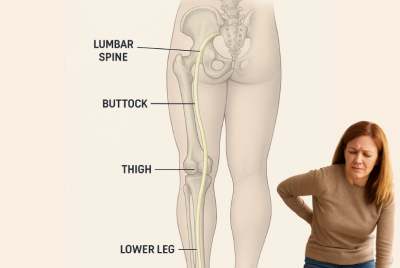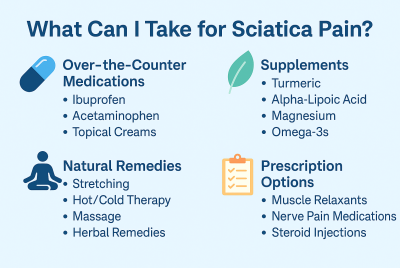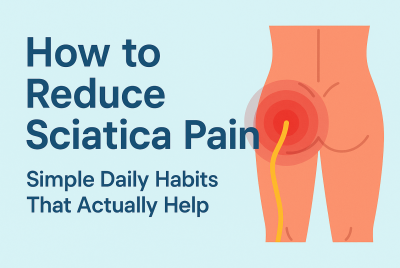Immediate Relief For Sciatica Pain
Seeking immediate relief for sciatica pain? Discover proven methods and expert tips to alleviate pain quickly. Dive in for rapid relief! Our guide offers quick, effective tips to ease your discomfort. Learn stretches, home remedies, and more to get your life back on track! As an advisor on sciatica, I’m here to provide helpful suggestions and reasons for your immediate relief. If you’re currently experiencing sciatica pain, it can be incredibly discomforting and disruptive to your daily life. Fortunately, there are various measures you can take to find relief and alleviate the pain. In this article, we will explore different strategies for immediate relief, as well as long-term management and prevention of sciatica pain.
Introduction
Sciatica pain can range from mild to severe, causing a sharp, shooting pain that radiates from the lower back down through the leg. It occurs due to the compression or irritation of the sciatic nerve, the largest nerve in the body. Finding immediate relief is crucial to regain mobility and minimize discomfort.
Understanding Sciatica
Sciatica occurs when the sciatic nerve experiences pressure or irritation, causing pain, numbness, or tingling in the lower back and legs. Treatment varies by severity.
What Is Sciatica?
Sciatica refers to the pain that stems from the irritation or compression of the sciatic nerve. The sciatic nerve runs from the lower back, through the buttocks, and down each leg. When it becomes irritated or compressed, it can result in various symptoms, including pain, numbness, tingling, and weakness in the affected leg.
What Triggers Sciatica?
Sciatica triggers often include herniated discs, spinal stenosis, or spondylolisthesis, which put pressure on the sciatic nerve. Pregnancy, obesity, and prolonged sitting can also contribute to the onset of symptoms. Muscle spasms in the back or buttocks may irritate the nerve further. In some cases, injury or infection could lead to sciatica. Consult a healthcare provider for accurate diagnosis and treatment.
Causes Of Sciatica
Sciatica can be caused by several factors, such as a herniated disc, spinal stenosis, degenerative disc disease, or even muscle spasms. These conditions can lead to pressure on the sciatic nerve, resulting in pain and discomfort.
Identifying Sciatica Symptoms
Before considering immediate relief options, it’s essential to identify the symptoms of sciatica. These may include persistent lower back pain, shooting pain down the leg, numbness or tingling in the leg or foot, weakness in the leg or foot muscles, and difficulty in moving the affected leg.
How Do I Unpinch A Sciatic Nerve?
To unpinch a sciatic nerve, start by consulting a healthcare provider for an accurate diagnosis and personalized treatment plan. Try cold and hot packs alternately on the affected area for immediate relief. Stretching exercises, particularly those aimed at loosening the piriformis muscle, can often relieve nerve pinching. Physical therapy can provide targeted exercises to help. Over-the-counter medications like ibuprofen can reduce inflammation and relieve pain. In more severe cases, corticosteroid injections or surgical options like a laminectomy might be considered. Always consult your healthcare provider for a treatment plan tailored to your needs.
Immediate Relief For Sciatica Pain
Rest And Gentle Stretching
Taking a short period of rest can help alleviate the pain and reduce inflammation. Engaging in gentle stretching exercises, such as knee-to-chest stretches or pelvic tilts, can provide relief by easing muscle tension and promoting flexibility.
Rest and gentle stretching can be effective strategies for finding immediate relief from sciatica pain. Start by resting in a comfortable position that alleviates pressure on the affected area. Then, incorporate gentle stretching exercises targeting the lower back, hips, and hamstrings. These stretches can help relieve tension and reduce inflammation. However, consulting with a healthcare professional for a proper diagnosis and personalized treatment plan is essential.
Heat And Cold Therapy
Alternating between heat and cold therapy can help soothe the affected area. Applying a hot or cold pack to the lower back can reduce inflammation, alleviate pain, and improve blood circulation.
Heat and cold therapy can be beneficial in finding immediate relief from sciatica pain. Applying a heating pad or taking a warm bath can help relax the muscles and improve blood flow to the affected area. On the other hand, using an ice pack or cold compress can reduce inflammation and numb the pain. Alternating between heat and cold therapy can provide additional relief. However, it’s essential to follow proper guidelines and consult a healthcare professional for guidance.
Over-The-Counter Pain Medication
Nonsteroidal anti-inflammatory drugs (NSAIDs) like ibuprofen or naproxen can help reduce pain and inflammation associated with sciatica. However, it’s important to follow the recommended dosage and consult a healthcare professional if necessary.
Over-the-counter pain medication can offer immediate relief from sciatica pain. Nonsteroidal anti-inflammatory drugs (NSAIDs) such as ibuprofen or naproxen can help reduce inflammation and alleviate discomfort. Acetaminophen can also be used to relieve pain. However, it’s important to follow the recommended dosage and consult with a healthcare professional if you have any underlying medical conditions or are taking other medications to ensure safety and effectiveness
Physical Therapy
A physical therapist can provide personalized exercises and stretches to alleviate sciatica pain. They can also help improve posture, strengthen core muscles, and enhance overall flexibility and mobility.
Through targeted exercises and techniques, physical therapy can provide immediate relief from sciatica pain. A physical therapist can assess your condition and design a personalized treatment plan. They may include stretches, strengthening exercises, and manual therapy to improve flexibility, reduce inflammation, and alleviate nerve compression. Additionally, they can provide education on proper posture and body mechanics to prevent further pain. Consistency and adherence to the physical therapy program are crucial for optimal results.
Acupuncture For Immediate Relief Of Sciatica Pain
Acupuncture, a traditional Chinese therapy, involves inserting thin needles into specific points on the body. It is believed to stimulate the nervous system, release endorphins, and reduce pain. Consult a licensed acupuncturist for this treatment option.
Acupuncture is a potential strategy for immediate relief from sciatica pain. It involves the insertion of thin needles into specific points on the body to stimulate energy flow. Acupuncture may help reduce pain, inflammation, and muscle tension associated with sciatica. However, the effectiveness can vary from person to person. It’s essential to consult with a licensed acupuncturist to determine if this therapy suits you and ensure proper technique and safety.
Chiropractic Care
Chiropractic adjustments can help realign the spine, reducing pressure on the sciatic nerve and alleviating pain. A qualified chiropractor can provide adjustments tailored to your specific condition.
Chiropractic care can offer immediate relief from sciatica pain through spinal adjustments and manipulations. A chiropractor will assess your condition and use targeted techniques to realign the spine, reduce nerve compression, and alleviate pain. They may also recommend exercises, stretches, and lifestyle modifications to support long-term healing. However, the effectiveness of chiropractic care may vary among individuals, and it’s essential to consult with a qualified chiropractor and discuss any underlying conditions or concerns.
Yoga and Pilates
Yoga and Pilates can improve strength, flexibility, and posture. Specific poses and exercises targeting the lower back and hips can help relieve sciatica pain. It’s advisable to join classes led by experienced instructors to ensure proper form and technique.
Yoga and Pilates can provide strategies for immediate relief from sciatica pain. Both practices focus on strengthening and stretching the muscles, improving flexibility, and promoting proper alignment. Specific poses and exercises can specifically target the lower back, hips, and hamstrings, which are common areas of tension in sciatica. However, it’s crucial to practice under the guidance of a qualified instructor and modify movements according to your comfort level to avoid aggravating the condition.
Massage Therapy For Immediate Relief For Sciatica
Massage therapy can help relax tense muscles and improve blood circulation. A skilled massage therapist can target the affected areas, providing relief and reducing pain associated with sciatica.
Massage therapy can be an effective strategy for immediate relief from sciatica pain. A skilled massage therapist can target the affected muscles and soft tissues to reduce tension, improve blood circulation, and alleviate discomfort. Techniques like deep tissue massage, trigger point therapy, and myofascial release can help release tightness and relieve nerve compression. However, it’s important to consult with a licensed massage therapist and communicate your symptoms and preferences for a safe and effective session.
Posture Correction For Immediate Relief For Sciatica
Maintaining good posture is essential in managing and preventing sciatica pain. Focusing on proper ergonomics, using supportive chairs, and avoiding prolonged sitting or standing can significantly reduce the risk of sciatica flare-ups.
Correcting posture can contribute to immediate relief from sciatica pain. Maintaining proper alignment while sitting, standing, and moving can reduce stress on the lower back and alleviate nerve compression. Keeping a neutral spine, using ergonomic chairs or supportive cushions, and engaging in regular posture exercises can help improve posture. It’s important to be mindful of posture throughout the day and make necessary adjustments to reduce pain and prevent further aggravation.
Exercise And Strengthening
Engaging in regular exercise and strengthening activities can improve core muscle strength and support the spine. Low-impact exercises like swimming, walking, and cycling can be beneficial for managing sciatica pain.
Exercise and strengthening strategies can provide immediate relief from sciatica pain. Engaging in low-impact activities like walking, swimming, or cycling can help improve circulation and alleviate discomfort. Additionally, targeted strengthening exercises focusing on the core, lower back, and hips can provide stability and support to the affected area. However, starting slowly and consulting with a healthcare professional or physical therapist for proper guidance and ensuring exercises are safe and appropriate for your condition is crucial.
Healthy Diet And Weight Management
Maintaining a healthy weight can reduce the strain on the lower back and minimize the risk of sciatica. Incorporating a balanced diet rich in fruits, vegetables, lean proteins, and whole grains can support overall well-being.
Maintaining a healthy diet and managing weight can contribute to immediate relief from sciatica pain. A nutritious diet rich in fruits, vegetables, lean proteins, and whole grains can help reduce inflammation and promote overall wellness. Additionally, managing weight within a healthy range can alleviate pressure on the lower back and reduce strain on the sciatic nerve. It’s important to consult with a healthcare professional for personalized dietary and weight management recommendations.
Stress Management
Chronic stress can contribute to muscle tension and exacerbate sciatica pain. Incorporating stress-management techniques such as deep breathing exercises, meditation, or engaging in hobbies can help alleviate pain and promote relaxation.
Implementing stress management strategies can provide immediate relief from sciatica pain. Chronic stress can exacerbate pain levels and tension in the body. Techniques such as deep breathing exercises, meditation, mindfulness, and engaging in activities that promote relaxation can help reduce stress and promote pain relief. Additionally, seeking support from a mental health professional or joining support groups can provide coping mechanisms and emotional support.
Cupping For Immediate Relief Of Sciatica
Cupping is a strategy that may offer immediate relief from sciatica pain. It involves placing cups on the skin to create suction, increase blood flow, relax muscles, and reduce inflammation. This technique is believed to stimulate the body’s natural healing processes. However, it’s important to consult with a licensed practitioner and discuss your specific condition to determine if cupping is a suitable treatment option for you.
Immediate Relief For Sciatica Pain Stretches
What Are The Best And Worst Exercises For Sciatica?
For sciatica relief, the best exercises often include gentle stretching and strength-building moves like the piriformis stretch, hamstring stretch, and pelvic tilts. Core-strengthening exercises can also support your lower back. On the flip side, high-impact activities such as running or intense weightlifting can worsen symptoms. Exercises that involve heavy twisting or bending, like full sit-ups or twisting lunges, should generally be avoided. Leg lifts can put excessive strain on the lower back, exacerbating pain. Always consult a healthcare provider or a qualified physiotherapist for personalized exercise recommendations tailored to your specific condition.
What Are The Top 3 Exercises For Sciatica?
The top three exercises often recommended for sciatica relief are:
- Piriformis Stretch: Lie on your back, bend both knees and cross one leg over the other. Pull the crossed knee towards your opposite shoulder, holding for 30 seconds.
- Hamstring Stretch: Sit on the floor with one leg outstretched and the other bent. Reach toward your outstretched foot while keeping your back straight. Hold for 30 seconds.
- Pelvic Tilts: Lie on your back with your knees bent. Tighten your abdominal muscles and push your lower back into the floor, holding for 5 seconds.
Consult a healthcare provider for a tailored exercise plan.
What Is A Home Remedy For Sciatic Nerve
For a home remedy to relieve sciatic nerve pain, apply a cold pack to the affected area for 15 minutes, followed by a hot pack for another 15 minutes. Gentle stretching exercises focusing on the lower back, hips, and legs can also alleviate tension and pain. Some people find relief using herbal remedies like turmeric or ginger tea for their anti-inflammatory properties. Over-the-counter pain relievers like ibuprofen can help temporarily. Always maintain proper posture and ergonomics while sitting or standing to reduce pressure on the sciatic nerve. Consult a healthcare provider for a personalized treatment plan.
Prevention And Long-Term Management
Prevention and long-term management of sciatica pain involve adopting healthy habits and lifestyle changes. Regular exercise, particularly activities that strengthen the core muscles and promote flexibility, can help support the spine and reduce the risk of sciatica flare-ups. Maintaining a healthy weight is crucial, as excess weight can put added strain on the lower back. Practicing good posture and avoiding prolonged sitting or standing can also help prevent sciatica pain. Additionally, using proper lifting techniques, incorporating stress management strategies, and seeking professional help for underlying conditions contribute to long-term management and reducing the likelihood of sciatica pain recurrence.
What Can Make Sciatica Worse
Certain factors can exacerbate sciatica symptoms. Prolonged sitting or standing, especially in poor ergonomic conditions, can put extra pressure on the sciatic nerve. Heavy lifting and twisting movements can worsen herniated discs or spinal stenosis, aggravating sciatica. Obesity increases spinal pressure, potentially making symptoms worse. High heels and unsupportive footwear can misalign your posture, contributing to discomfort. Stress and lack of exercise may also lead to muscle tension that irritates the sciatic nerve. Smoking can impair blood flow and oxygen to the discs, worsening the condition. Always consult a healthcare provider for a comprehensive treatment plan.
When To Seek Medical Help
While immediate relief strategies can provide significant relief, it’s essential to consult a healthcare professional if the pain persists or worsens over time. They can provide a comprehensive diagnosis, recommend appropriate treatments, and suggest further medical interventions if necessary.
Frequently Asked Questions (FAQs)
Can immediate relief strategies completely cure sciatica?
Immediate relief strategies can help alleviate sciatica pain, but they may not provide a permanent cure. Adopting long-term management strategies and seeking medical advice for comprehensive treatment is important.
Are there any specific exercises to avoid with sciatica pain?
High-impact activities, heavy lifting, and exercises that involve excessive twisting or bending of the back should be avoided. It’s best to consult a healthcare professional or a physical therapist for personalized exercise recommendations.
How long does it take to experience relief from sciatica pain?
The time it takes to experience relief from sciatica pain can vary depending on the individual and the severity of the condition. Some people may find relief within a few days or weeks, while others may require more time and a combination of treatments.
Can sciatica pain be a sign of a more serious condition?
Sciatica pain can sometimes be a symptom of an underlying condition, such as a herniated disc or spinal stenosis. If the pain is persistent, worsens over time, or is accompanied by other concerning symptoms, it’s crucial to seek medical help for a proper diagnosis.
Can lifestyle changes help prevent sciatica pain in the long term?
Yes, adopting a healthy lifestyle can contribute to preventing sciatica pain. Regular exercise, maintaining a healthy weight, practicing good posture, and avoiding excessive sitting or standing can reduce the risk of sciatica flare-ups and promote overall spinal health.
Extra FAQs Related To Immediate Relief For Sciatica Pain
What relaxes the sciatic nerve?
Stretching exercises, cold and hot packs, and over-the-counter pain relievers like ibuprofen can relax the sciatic nerve. Proper posture and ergonomic support also help. Consult a healthcare provider for a personalized treatment plan.
How to relieve sciatica pain in bed?
Try lying on your back with a pillow under your knees to relieve sciatica pain in bed. Side-sleepers can place a pillow between their knees. Elevating legs and using heat or ice may also help.
What is the best cream for sciatica pain?
The best cream for sciatica pain varies by individual needs and sensitivities. Consult your healthcare provider for personalized advice. Over-the-counter options often include creams with menthol, capsaicin, or a nonsteroidal anti-inflammatory drug.
What is the quickest way to ease sciatica?
Apply a cold or hot pack to the affected area for quick sciatica relief. Over-the-counter pain relievers like ibuprofen may also help. However, consult a healthcare provider for a comprehensive treatment plan.
Immediate Relief For Sciatica Pain – Conclusion
Sciatica pain can be debilitating, but with the right strategies, immediate relief is possible. By combining rest, gentle stretching, heat or cold therapy, over-the-counter pain medication, physical therapy, and alternative treatments like acupuncture or chiropractic care, individuals can find relief and improve their quality of life. Remember to incorporate long-term preventive measures and seek medical help if needed.
Disclaimer
Please note that the information provided in this article is for informational purposes only and should not replace professional medical advice. If you’re experiencing sciatica pain or any health concerns, it’s advisable to consult a healthcare professional for proper diagnosis and treatment.
👉 Explore more:




